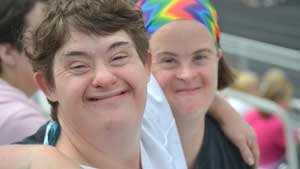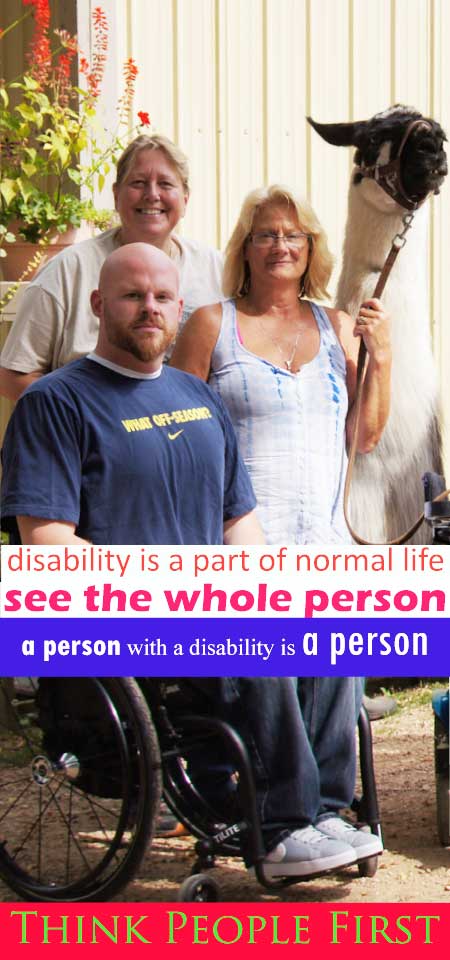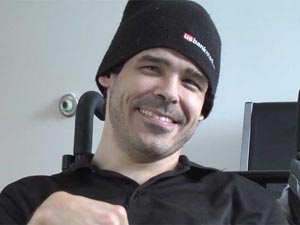 Seeing someone with a disability might be uncomfortable. You may be hesitant to introduce yourself, start a conversation, or get to know someone.
Seeing someone with a disability might be uncomfortable. You may be hesitant to introduce yourself, start a conversation, or get to know someone. 
Too often, disability labels, stereotypes, and assumptions get in the way of finding out about a person. Although a disability has an impact, it is only a small part of a person’s identity. No one is their disability. We encourage you to see people with disabilities as people, first. Using the “People First” language we describe is one way to let people know you see them, not just their disability. When you see people first, you and they will notice the difference.
Think People First
A PERSON is someone with autism or polio . . . one is not afflicted by it.
A PERSON uses a wheelchair or is someone with a disability . . . one is not crippled, confined to a wheelchair, or wheelchair-bound.
THE PERSON has a hearing impairment or uses an alternative listening device . . . and is not dumb, or a deaf mute.
THE PERSON has epilepsy, or has a seizure disorder . . . and is not spastic or an epileptic.
THE PERSON is someone with Down Syndrome . . . not a Mongoloid.
THE CHILD has a disability or has a chronic illness . . . not a special needs child or a special person.
He or she is A PERSON with a disability, or someone with an intellectual or other developmental disability, not "mentally challenged," "physically challenged," "intellectually deficient," or "retarded." The term "mental retardation" is almost never acceptable. "Retarded" is a hurtful slur. The correct term is "person with an intellectual disability."
When we begin to see the person, and talk about the person first, we get to know the person and put the disability into perspective. We can begin to see that the individual has a personality, qualities and interests— all of which go far beyond his or her disability.
No one wants to be defined by only one part of who they are. To get to know anyone, including a person with a disability, takes time.
Tips for Seeing People First
Talk directly to the person with the disability and maintain eye contact, even when the person is using an interpreter or a direct support professional.
Encourage the person with the disability to express his or her own thoughts, even if others try to speak for the individual.
If you offer assistance to the person with a disability and he or she says, "No thanks," respect the person’s ability to handle the circumstances.
Use a normal tone of voice. If the person cannot hear, or understand you, he or she will let you know.
 When speaking with a person with an intellectual disability, talk in clear, short, direct sentences. To be certain that you’ve communicated effectively, ask the person to repeat the idea back to you in their own words.
When speaking with a person with an intellectual disability, talk in clear, short, direct sentences. To be certain that you’ve communicated effectively, ask the person to repeat the idea back to you in their own words.
In social settings, treat a person with a disability in the same way as anyone else.
Use the same conversational terms, such as “see,” “hear,” and “look” for a person who is blind. It is all right to use terms such as "let's walk over," even when the person uses a wheelchair.
When talking with a person using a wheelchair, if possible, sit next to the individual so you are at the same level. However, don't kneel.
Be mindful if an assistive animal or "seeing eye dog" is on duty. Petting or otherwise distracting the animal is not okay, unless the owner approves.
Encourage others to interact with people with disabilities. Open, informed interaction helps overcome fear and stereotypes. People with disabilities are their own best spokespeople. Disability is a normal part of life.